-
 Title-page: AMINTA | FAVOLA BOSCARECCIA | DI | TORQUATO TASSO | CON | LE ANNOTATIONI | D'EGIDIO MENAGIO | ACCADEMICO | DELLA CRVSCA• | {woodcut vignette} | IN PARIGI| Presso AGOSTINO Cvrbe`, nella Galeria del Palazzo, | all’ insegna della Palma. |—| M. DC. LV. || Collation: 4to; ā4 ē4 ī4 A2 B2 C-V4 Y-Z4 2A1,2 X4 2A3,4 2B-2Z4, 3A-3B4, total number of leaves = 200. Note: O2, 2K3, 2V3 2X3 2Y3, and 3B3 – unsigned, 2Z3 signed 2Z2 (Zzij), quire X (pp. 145-152) bound between 2A2 (p. 172) and 2A3 (p. 173); illustrated throughout with woodcut head- and tailpieces and initials, Atto Primo has copperplate engraved historiated initial and a headpiece signed “F. C. in. — I. B. fe.” “I. B.” was a monogram of engraver Giulio Bonasone (Italian, c. 1498 – after 1574). Pagination: [2] – t.p. / blank, [8] – dedication, i-xviii, [4], 1-341 [342-368]; total number of pages = 400. Binding: 22.3 x 18 cm, 19th-century quarter morocco over marbled boards, spine with raised bands and gilt lettering, rebacked, additional blank flyleaves at front and back, marbled endpapers and all edges. Bookplate to front pastedown: “The Robin Collection”. Verso front flyleaf stamped “RESTORED BY MACDONALD CO. | NORWALK. CONN. Provenance: The Robin Collection. Contributors: Torquato Tasso (Italian, 1544 –1595) – author. Gilles Ménage (French, 1613 – 1692) – author. Antoine Vitré (French, 1595 – 1674) – printer. Augustin Courbé (French, fl. c. 1625 – 1660) – publisher. Marie-Madeleine Pioche de La Vergne, comtesse de La Fayette (French, 1634 – 1693) – dedicatee.
Title-page: AMINTA | FAVOLA BOSCARECCIA | DI | TORQUATO TASSO | CON | LE ANNOTATIONI | D'EGIDIO MENAGIO | ACCADEMICO | DELLA CRVSCA• | {woodcut vignette} | IN PARIGI| Presso AGOSTINO Cvrbe`, nella Galeria del Palazzo, | all’ insegna della Palma. |—| M. DC. LV. || Collation: 4to; ā4 ē4 ī4 A2 B2 C-V4 Y-Z4 2A1,2 X4 2A3,4 2B-2Z4, 3A-3B4, total number of leaves = 200. Note: O2, 2K3, 2V3 2X3 2Y3, and 3B3 – unsigned, 2Z3 signed 2Z2 (Zzij), quire X (pp. 145-152) bound between 2A2 (p. 172) and 2A3 (p. 173); illustrated throughout with woodcut head- and tailpieces and initials, Atto Primo has copperplate engraved historiated initial and a headpiece signed “F. C. in. — I. B. fe.” “I. B.” was a monogram of engraver Giulio Bonasone (Italian, c. 1498 – after 1574). Pagination: [2] – t.p. / blank, [8] – dedication, i-xviii, [4], 1-341 [342-368]; total number of pages = 400. Binding: 22.3 x 18 cm, 19th-century quarter morocco over marbled boards, spine with raised bands and gilt lettering, rebacked, additional blank flyleaves at front and back, marbled endpapers and all edges. Bookplate to front pastedown: “The Robin Collection”. Verso front flyleaf stamped “RESTORED BY MACDONALD CO. | NORWALK. CONN. Provenance: The Robin Collection. Contributors: Torquato Tasso (Italian, 1544 –1595) – author. Gilles Ménage (French, 1613 – 1692) – author. Antoine Vitré (French, 1595 – 1674) – printer. Augustin Courbé (French, fl. c. 1625 – 1660) – publisher. Marie-Madeleine Pioche de La Vergne, comtesse de La Fayette (French, 1634 – 1693) – dedicatee. -
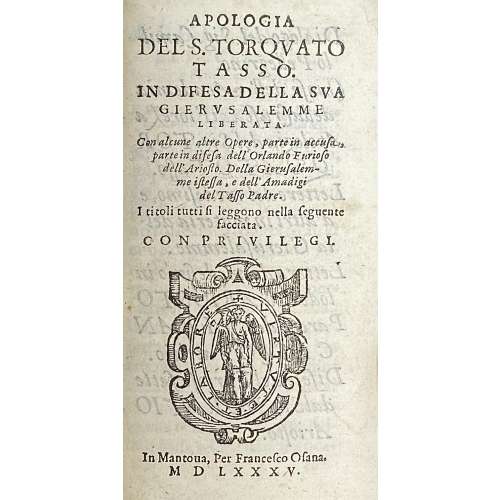 Title-page: APOLOGIA | DEL S. TORQVATO | TASSO. | IN DIFESA DELLA SVA | GIERVSALEMME | LIBERATA. | Con alcune Opere, partien in accusa, | partein difesa dell Orlando Furioso | dell’Ariosto. | Della Gierusalem- | me istessa , e dell’Amadigi | del Tasso Padre. | I titoli tutti si leggono nella feguente | facciata. | con privilegi. | {publisher’s device} | In Mantoua, Per Francesco Osana. | M D LXXXV. || 1st blank π1, [a]-a8; (9 leaves, 18 pp., unpaginated) Divisional t.p. (1): DE GLI | ACCADEMICI | DELLA CRVSCA | DIFESA DELL’ ORLANDO | FVRIOSO DELL’ ARIOSTO | Contra’l Dialogo dell’Epica | poesia di Camillo | Pellegrino. | Stacciata prima. | {woodcut} ||; A-E12 [2]A1 (61 leaves, 122 pp., unpaginated). Divisional t.p. (2): APOLOGIA | DEL S. TORQVATO | TASSO. | IN DIFESA DELLA SVA | GIERVSALEMME | LIBERATA. | {publisher’s device} | IN MANTOVA, |—| Per Francesco Osanna. | MDLXXXV. || [2]A11 2B-[2]I12 [2]K4, pp. [2] 3-219 [3] (111 leaves, 222 pages). Divisional t.p. (3): DELL’ | INFARINATO | ACADEMICO | DELLA CRVSCA … etc. | MDLXXXV. | Con licenza de’ Superiori. || [3]A-[3]G12, pp. [2] 3-164, 163 (i.e. 165) [3] (84 leaves, 168 pages). Divisional t.p. (4): RIPOSTA | DEL S. TORQVATO | TASSO, | ALLA LETTERA | DI BASTIAN ROSSI, …etc. | MDLXXXV. | Con licenza de’ Superiori. || [4]A-[4]E12 F8, ([4]B3 i.e. [4]A3), pp. [2] 3-135 [1] (68 leaves, 136 pages). Divisional t.p. (5): DISCORSO | IN TORNO | A’CONTRASTI, | CHE SI FANNO | SOPRA… ect. | M D LXXXVI. || [5]A-[5]D12 E4, pp. [2]3-67, 66 (i.e. 68), 92 (69), 70-73 (70-73), 94 (74), 95 (75), 76, 77, 98-115 (78-95), 112 (96), 97-100, [4] (52 leaves, 104 pages). Divisional t.p. (6): PARERE | DEL SIGNOR | TORQVATO | TASSO. | SOPRA IL DISCORSO | del Signor Horatio Lom- | bardello intorno a’ | contrasti,&c. … etc. | M D LXXXVI. || [6]A12 [6]B6 (incl. last blank), pp. [1-5] 6-33 [3] (18 leaves, 36 pages). Collation: 12mo; π1, a8, A-E12, [2]A-[2]I12 [2]K4, [3]A-[3]G12, [4]A-[4]E12 F8, [5]A-[5]D12 E4, [6]A12 [6]B6 (incl. last blank), total 403 leaves, 806 pages, in-text woodcut head- and tailpieces, and initials. Binding: 14.4 x 9 cm, 19th-century quarter calf over marbled boards, raised bands, gilt-bordered compartments, gilt lettering, three flyleaves at the front and back, "The Robin Collection" bookplate to front pastedown. Provenance: The Robin Collection. Contributors: Torquato Tasso (Italian, 1544 –1595) – author. Orazio Ariosto (Italian, 1555 – 1593) – author. Ludovico Ariosto (Italian, 1474 – 1533) – author. Camillo Pellegrino (Italian, 1527-1603) – author. Francesco Osanna [Osana] (Italian, fl. 1549 – 1608) – printer, publisher.
Title-page: APOLOGIA | DEL S. TORQVATO | TASSO. | IN DIFESA DELLA SVA | GIERVSALEMME | LIBERATA. | Con alcune Opere, partien in accusa, | partein difesa dell Orlando Furioso | dell’Ariosto. | Della Gierusalem- | me istessa , e dell’Amadigi | del Tasso Padre. | I titoli tutti si leggono nella feguente | facciata. | con privilegi. | {publisher’s device} | In Mantoua, Per Francesco Osana. | M D LXXXV. || 1st blank π1, [a]-a8; (9 leaves, 18 pp., unpaginated) Divisional t.p. (1): DE GLI | ACCADEMICI | DELLA CRVSCA | DIFESA DELL’ ORLANDO | FVRIOSO DELL’ ARIOSTO | Contra’l Dialogo dell’Epica | poesia di Camillo | Pellegrino. | Stacciata prima. | {woodcut} ||; A-E12 [2]A1 (61 leaves, 122 pp., unpaginated). Divisional t.p. (2): APOLOGIA | DEL S. TORQVATO | TASSO. | IN DIFESA DELLA SVA | GIERVSALEMME | LIBERATA. | {publisher’s device} | IN MANTOVA, |—| Per Francesco Osanna. | MDLXXXV. || [2]A11 2B-[2]I12 [2]K4, pp. [2] 3-219 [3] (111 leaves, 222 pages). Divisional t.p. (3): DELL’ | INFARINATO | ACADEMICO | DELLA CRVSCA … etc. | MDLXXXV. | Con licenza de’ Superiori. || [3]A-[3]G12, pp. [2] 3-164, 163 (i.e. 165) [3] (84 leaves, 168 pages). Divisional t.p. (4): RIPOSTA | DEL S. TORQVATO | TASSO, | ALLA LETTERA | DI BASTIAN ROSSI, …etc. | MDLXXXV. | Con licenza de’ Superiori. || [4]A-[4]E12 F8, ([4]B3 i.e. [4]A3), pp. [2] 3-135 [1] (68 leaves, 136 pages). Divisional t.p. (5): DISCORSO | IN TORNO | A’CONTRASTI, | CHE SI FANNO | SOPRA… ect. | M D LXXXVI. || [5]A-[5]D12 E4, pp. [2]3-67, 66 (i.e. 68), 92 (69), 70-73 (70-73), 94 (74), 95 (75), 76, 77, 98-115 (78-95), 112 (96), 97-100, [4] (52 leaves, 104 pages). Divisional t.p. (6): PARERE | DEL SIGNOR | TORQVATO | TASSO. | SOPRA IL DISCORSO | del Signor Horatio Lom- | bardello intorno a’ | contrasti,&c. … etc. | M D LXXXVI. || [6]A12 [6]B6 (incl. last blank), pp. [1-5] 6-33 [3] (18 leaves, 36 pages). Collation: 12mo; π1, a8, A-E12, [2]A-[2]I12 [2]K4, [3]A-[3]G12, [4]A-[4]E12 F8, [5]A-[5]D12 E4, [6]A12 [6]B6 (incl. last blank), total 403 leaves, 806 pages, in-text woodcut head- and tailpieces, and initials. Binding: 14.4 x 9 cm, 19th-century quarter calf over marbled boards, raised bands, gilt-bordered compartments, gilt lettering, three flyleaves at the front and back, "The Robin Collection" bookplate to front pastedown. Provenance: The Robin Collection. Contributors: Torquato Tasso (Italian, 1544 –1595) – author. Orazio Ariosto (Italian, 1555 – 1593) – author. Ludovico Ariosto (Italian, 1474 – 1533) – author. Camillo Pellegrino (Italian, 1527-1603) – author. Francesco Osanna [Osana] (Italian, fl. 1549 – 1608) – printer, publisher. -
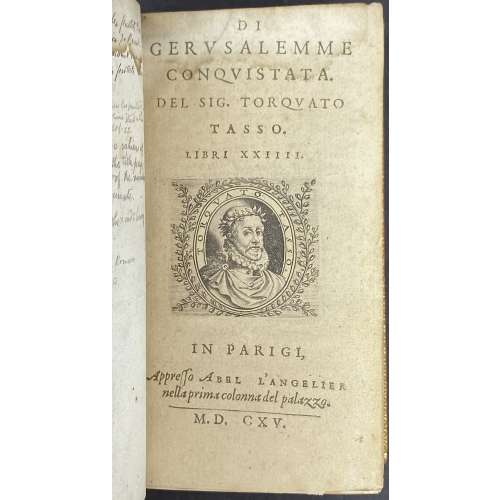 Title-page (1): DI | GERVSALEMME | CONQVISTATA. | DEL SIG. TORQVATO | TASSO. | LIBRI XXIIII. | {engraved portrait of Torquato Tasso in lettered oval medallion surrounded with laurel branches} | IN PARIGI, | Appresso Abel L’ANGELIER | nella prima Colonna del palazzo. | M.D. CXV. || Title-page (2): DI | GERVSALEMME | CONQVISTATA. | DEL SIG. TORQVATO | TASSO. | LIBRI XXIIII. | ALL’ ILL. MO ET REV. MO| SIG. RE| IL SIGNOR. | CINTHIO ALDOBRANDINI | Card. Di San Giorgio. | Appresso Abel L’ANGELIERI | nella prima Colonna del palazzo. | M.D. LCXV. || Collation: 1st blank leaf with an extensive pencil MS in French and English (unsigned), 1st t.p. / blank (unsigned), 2nd t.p. / blank [ai] (unsigned), Dedication by Angelo Ingegneri dated 10-NOV-1592 (ã2-ã5), dedication by Torquato Tasso and Aux Lecteur by Abel L’Angelier ã5[i.e. 6]-[ã9]; 12mo: π12, A-Z12, 2A-2Q12 (2Q11 woodcut / blank, 2Q12 blank), total 480 leaves, with woodcut head- and tailpieces, historiated initials. Note: leaves D6, M3, M6, and N3 unsigned; leave E2 signed for F2, E4 – for F4, Z – for Z5, and A – for Aa. Pagination: 12 prelims unpag., 1-361, each leaf paginated as one page) [2]; with a lot of mispaginations: shall be 1-468, but after p.291 follows 278 (for 292), then 193 for 293, etc. Binding: 14.5 x 8.5 cm, 20th-century tan morocco by Zaehnsdorf (signed in gilt), gilt fleurons in corners and in compartments, raised bands, titles on spine, gilt dentelles, marbled endpapers plus 6 fep at the front (one with pasted clipping “A PARIS, Chez Fetil, Libraire, rue des Cor-| deliers, près celle de Condé, au | Parnasse Italien”, and 2 at the end. What connection has the 18th-century publisher with this edition remains unclear. “The Robin Collection” bookplate to front pastedown. Edges sprinkled red. Occasional damp staining to top margins. There is controversy regarding the year of this publication. It could be 1615 (MDCXV), however, both the publisher and the dedicatee were dead this year. Dedication by the publisher dated 1592. We agree with those scholars who suggest that MDCXV and MDLCXV were misprinted for MDXCV (1595). Provenance: The Robin Collection. Contributors: Torquato Tasso (Italian, 1544 –1595) – author. Angelo Ingegneri (Italian, 1550 – 1613) – author. Abel L'Angelier (French, 1553? – 1610) – printer, publisher. Cinzio Aldobrandini (Italian, 1551 – 1610) – dedicatee.
Title-page (1): DI | GERVSALEMME | CONQVISTATA. | DEL SIG. TORQVATO | TASSO. | LIBRI XXIIII. | {engraved portrait of Torquato Tasso in lettered oval medallion surrounded with laurel branches} | IN PARIGI, | Appresso Abel L’ANGELIER | nella prima Colonna del palazzo. | M.D. CXV. || Title-page (2): DI | GERVSALEMME | CONQVISTATA. | DEL SIG. TORQVATO | TASSO. | LIBRI XXIIII. | ALL’ ILL. MO ET REV. MO| SIG. RE| IL SIGNOR. | CINTHIO ALDOBRANDINI | Card. Di San Giorgio. | Appresso Abel L’ANGELIERI | nella prima Colonna del palazzo. | M.D. LCXV. || Collation: 1st blank leaf with an extensive pencil MS in French and English (unsigned), 1st t.p. / blank (unsigned), 2nd t.p. / blank [ai] (unsigned), Dedication by Angelo Ingegneri dated 10-NOV-1592 (ã2-ã5), dedication by Torquato Tasso and Aux Lecteur by Abel L’Angelier ã5[i.e. 6]-[ã9]; 12mo: π12, A-Z12, 2A-2Q12 (2Q11 woodcut / blank, 2Q12 blank), total 480 leaves, with woodcut head- and tailpieces, historiated initials. Note: leaves D6, M3, M6, and N3 unsigned; leave E2 signed for F2, E4 – for F4, Z – for Z5, and A – for Aa. Pagination: 12 prelims unpag., 1-361, each leaf paginated as one page) [2]; with a lot of mispaginations: shall be 1-468, but after p.291 follows 278 (for 292), then 193 for 293, etc. Binding: 14.5 x 8.5 cm, 20th-century tan morocco by Zaehnsdorf (signed in gilt), gilt fleurons in corners and in compartments, raised bands, titles on spine, gilt dentelles, marbled endpapers plus 6 fep at the front (one with pasted clipping “A PARIS, Chez Fetil, Libraire, rue des Cor-| deliers, près celle de Condé, au | Parnasse Italien”, and 2 at the end. What connection has the 18th-century publisher with this edition remains unclear. “The Robin Collection” bookplate to front pastedown. Edges sprinkled red. Occasional damp staining to top margins. There is controversy regarding the year of this publication. It could be 1615 (MDCXV), however, both the publisher and the dedicatee were dead this year. Dedication by the publisher dated 1592. We agree with those scholars who suggest that MDCXV and MDLCXV were misprinted for MDXCV (1595). Provenance: The Robin Collection. Contributors: Torquato Tasso (Italian, 1544 –1595) – author. Angelo Ingegneri (Italian, 1550 – 1613) – author. Abel L'Angelier (French, 1553? – 1610) – printer, publisher. Cinzio Aldobrandini (Italian, 1551 – 1610) – dedicatee. -
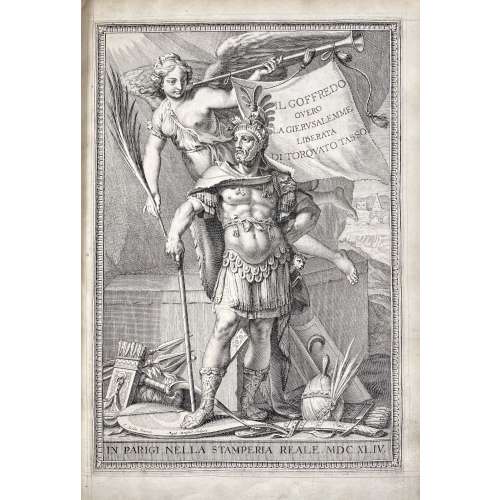 Title page: IL | GOFFREDO | OVERO | LA | GIERUSALEMME | LIBERATA | DI TORQUATO TASSO. || Engraved title: On the banner: IL GOFFREDO | OVERO | LA GIERUSALEMME | LIBERATA | DI TORQUATO TASSO ||; under the image, within frame: IN PARIGI NELLA STAMPERIA REALE MDC XLIV. Signed: J. Stella Invenit — Ægid Rousselet Sculpsit (with tall “s”) || Collation: 2 blank leaves with donation ink inscription to recto of the 1st: “Ex Dono Patruelis Do Roberto Willughby” [i.e. Robert Willoughby]; t.p. / blank, engraved t.p. by Gilles Rousselet after Jacques Stella / blank, “Allegoria dell poema” 4 leaves, 1st two leaves signed iij and iiij, respectively; π6 A-Z4 Aa-Zz4 Aaa-Rrr4, 2 blank leaves at the end; text paginated from 1 to 502 [2] (p. 503 tailpiece, p. 504 blank); a printable area marked with vertical and horizontal double lines; total: 252 leaves of text (504 pages), 6 prelims and 4 blanks. Illustrated throughout with head- and tailpieces, and historiated initials. Binding: 18th-century red crushed morocco, triple-fillet gilt border, triple-fillet gilt frame, panel with gilt lozenge centrepiece, lozenges at corners, marbled endpapers, AEG, crudely rebacked retaining original spine with raised bands, gilt in compartments, crimson label with gilt lettering; The Robin Collection bookplate to front pastedown. Provenance: The Robin Collection; Robert Willoughby family. Contributors: Torquato Tasso (Italian, 1544 –1595) – author. Jacques Stella (French, 1596 – 1657) – artist. Gilles [Aegidius] Rousselet (French, 1610 – 1686) – engraver.
Title page: IL | GOFFREDO | OVERO | LA | GIERUSALEMME | LIBERATA | DI TORQUATO TASSO. || Engraved title: On the banner: IL GOFFREDO | OVERO | LA GIERUSALEMME | LIBERATA | DI TORQUATO TASSO ||; under the image, within frame: IN PARIGI NELLA STAMPERIA REALE MDC XLIV. Signed: J. Stella Invenit — Ægid Rousselet Sculpsit (with tall “s”) || Collation: 2 blank leaves with donation ink inscription to recto of the 1st: “Ex Dono Patruelis Do Roberto Willughby” [i.e. Robert Willoughby]; t.p. / blank, engraved t.p. by Gilles Rousselet after Jacques Stella / blank, “Allegoria dell poema” 4 leaves, 1st two leaves signed iij and iiij, respectively; π6 A-Z4 Aa-Zz4 Aaa-Rrr4, 2 blank leaves at the end; text paginated from 1 to 502 [2] (p. 503 tailpiece, p. 504 blank); a printable area marked with vertical and horizontal double lines; total: 252 leaves of text (504 pages), 6 prelims and 4 blanks. Illustrated throughout with head- and tailpieces, and historiated initials. Binding: 18th-century red crushed morocco, triple-fillet gilt border, triple-fillet gilt frame, panel with gilt lozenge centrepiece, lozenges at corners, marbled endpapers, AEG, crudely rebacked retaining original spine with raised bands, gilt in compartments, crimson label with gilt lettering; The Robin Collection bookplate to front pastedown. Provenance: The Robin Collection; Robert Willoughby family. Contributors: Torquato Tasso (Italian, 1544 –1595) – author. Jacques Stella (French, 1596 – 1657) – artist. Gilles [Aegidius] Rousselet (French, 1610 – 1686) – engraver. -
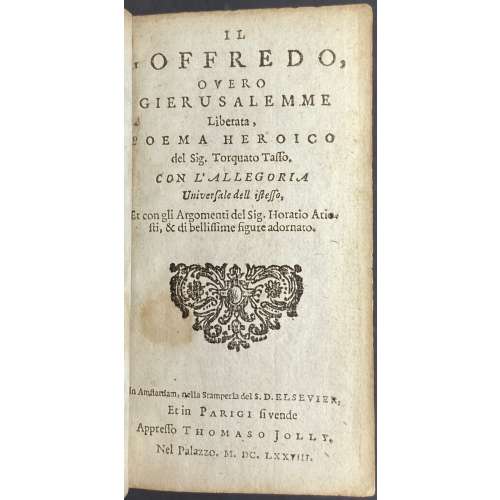 Vol. 1: Engraved t.p.: An architectural setting with flags and arms, and sitting male and female figures in armour, perhaps representing Tancredi and Clorinda, with lettering above their heads: “GIERVSA– | LEMME | LIBERATA”. Title-page: IL | GOFFREDO, | OVERO | GIERUSALEMME | Liberata , | POEMA HEROICO | del Sig. Torquato Tasso. | CON L’ ALLEGORIA | Universale dell istesso, | Et con gli Argomenti del Sig. Horatio Ario- | sti, & di belissime figure adornato. | {woodcut element} | In Amsterdam, nella Stamperia del S.D. ELZEVIER, | Et in Parigi, si vende | Appresso Thomaso Jolly. | Nel Palazzo, M. DC. LXXVIII. || Collation: 8vo; [A1] 1st blank, engraved t.p., [A2] letterpress t.p., pp. [1-4]; signatures start at A3, pagination starts at p. 37; Allegoria: A3-B1, pp. [5-18], Tavola: B2-C2, pp. [19-36]; Il Goffredo: C3-R8, pp. 37-271 [272]. Total A-R8: 136 leaves (272 pages), plus 11 plates, incl. engraved t.p., and frontispiece (sculptural bust portrait of Torquato Tasso in a laurel wreath, with a lettered plate below “TORQVATO | TASSO”). Vol. 1: Title-page: Similar but “TOMO II.” after “sti, & di belissime figure adornato.” and before the woodcut element. Collation: 8vo; 1st blank, letterpress t.p., signatures start at A3, p. 5; A-S8, pp. [4] 5-285 [3]. Total A-S8: 144 leaves (288 pages) plus 10 engraved plates. Binding: Two volumes 15 x 6 cm, uniformly bound in 19th-century green morocco, gilt triple-fillet border, bull heads at corners, spine with raised bands, gilt in compartments, two gilt-lettered crimson labels, blue endpapers, 2 blank laid paper leaves in the front, AEG. Contributors: Torquato Tasso (Italian, 1544 –1595) – author. Daniel Elzevir (Dutch, 1626-1680) – publisher. Thomas Jolly (French, fl. 1648 – 1694) – publisher.
Vol. 1: Engraved t.p.: An architectural setting with flags and arms, and sitting male and female figures in armour, perhaps representing Tancredi and Clorinda, with lettering above their heads: “GIERVSA– | LEMME | LIBERATA”. Title-page: IL | GOFFREDO, | OVERO | GIERUSALEMME | Liberata , | POEMA HEROICO | del Sig. Torquato Tasso. | CON L’ ALLEGORIA | Universale dell istesso, | Et con gli Argomenti del Sig. Horatio Ario- | sti, & di belissime figure adornato. | {woodcut element} | In Amsterdam, nella Stamperia del S.D. ELZEVIER, | Et in Parigi, si vende | Appresso Thomaso Jolly. | Nel Palazzo, M. DC. LXXVIII. || Collation: 8vo; [A1] 1st blank, engraved t.p., [A2] letterpress t.p., pp. [1-4]; signatures start at A3, pagination starts at p. 37; Allegoria: A3-B1, pp. [5-18], Tavola: B2-C2, pp. [19-36]; Il Goffredo: C3-R8, pp. 37-271 [272]. Total A-R8: 136 leaves (272 pages), plus 11 plates, incl. engraved t.p., and frontispiece (sculptural bust portrait of Torquato Tasso in a laurel wreath, with a lettered plate below “TORQVATO | TASSO”). Vol. 1: Title-page: Similar but “TOMO II.” after “sti, & di belissime figure adornato.” and before the woodcut element. Collation: 8vo; 1st blank, letterpress t.p., signatures start at A3, p. 5; A-S8, pp. [4] 5-285 [3]. Total A-S8: 144 leaves (288 pages) plus 10 engraved plates. Binding: Two volumes 15 x 6 cm, uniformly bound in 19th-century green morocco, gilt triple-fillet border, bull heads at corners, spine with raised bands, gilt in compartments, two gilt-lettered crimson labels, blue endpapers, 2 blank laid paper leaves in the front, AEG. Contributors: Torquato Tasso (Italian, 1544 –1595) – author. Daniel Elzevir (Dutch, 1626-1680) – publisher. Thomas Jolly (French, fl. 1648 – 1694) – publisher. -
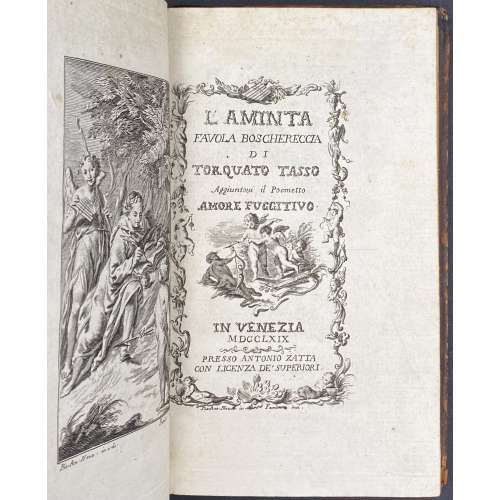 Engraved title-page: L'AMINTA | FAVOLA BOSCHERECCIA | DI | TORQUATO TASSO | Aggiuntovi il Poemetto | Amore Fugitivo |{vignette} | IN VENEZIA | MDCCLXIX |—| PRESSO ANTONIO ZATTA | CON LICENZA DE’ SUPERIORI || in historiated frame, signed below: “Pet. Ant. Novelli in — Fambrini inci.” Pagination: [i] ii-xxiv, [1-2] 3-84, total 108 pages, ils. Collation: 12mo; a12, A-C12 D6, last blank; first 6 leaves signed in 12-leave quires, first 3 in D; total 54 leaves plus 9 plates, incl. engraved title and frontispiece, and numerous head- and tailpieces by Fambrini after Novelli. Binding: 18.6 x 11 cm, contemporary tree calf, rebacked, crimson label with gilt lettering; clipping and bookplate of The Robin Collection to front pastedown; verso front flyleaf stamped “RESTORED BY MACDONALD CO. | NORWALK. CONN.” Additional blank leaves at front and back. Provenance: Satinsky, Robin F. (American, 1919 – 2008); The Robin Collection. Contributors: Torquato Tasso (Italian, 1544 –1595) – author. Pietro Antonio Novelli (Italian, 1729 – 1804) – artist. Ferdinando Fambrini (Italian (1764 – c.1793) – engraver. Antonio Zatta (Italian, c. 1722 – 1804) – printer, publisher.
Engraved title-page: L'AMINTA | FAVOLA BOSCHERECCIA | DI | TORQUATO TASSO | Aggiuntovi il Poemetto | Amore Fugitivo |{vignette} | IN VENEZIA | MDCCLXIX |—| PRESSO ANTONIO ZATTA | CON LICENZA DE’ SUPERIORI || in historiated frame, signed below: “Pet. Ant. Novelli in — Fambrini inci.” Pagination: [i] ii-xxiv, [1-2] 3-84, total 108 pages, ils. Collation: 12mo; a12, A-C12 D6, last blank; first 6 leaves signed in 12-leave quires, first 3 in D; total 54 leaves plus 9 plates, incl. engraved title and frontispiece, and numerous head- and tailpieces by Fambrini after Novelli. Binding: 18.6 x 11 cm, contemporary tree calf, rebacked, crimson label with gilt lettering; clipping and bookplate of The Robin Collection to front pastedown; verso front flyleaf stamped “RESTORED BY MACDONALD CO. | NORWALK. CONN.” Additional blank leaves at front and back. Provenance: Satinsky, Robin F. (American, 1919 – 2008); The Robin Collection. Contributors: Torquato Tasso (Italian, 1544 –1595) – author. Pietro Antonio Novelli (Italian, 1729 – 1804) – artist. Ferdinando Fambrini (Italian (1764 – c.1793) – engraver. Antonio Zatta (Italian, c. 1722 – 1804) – printer, publisher. -
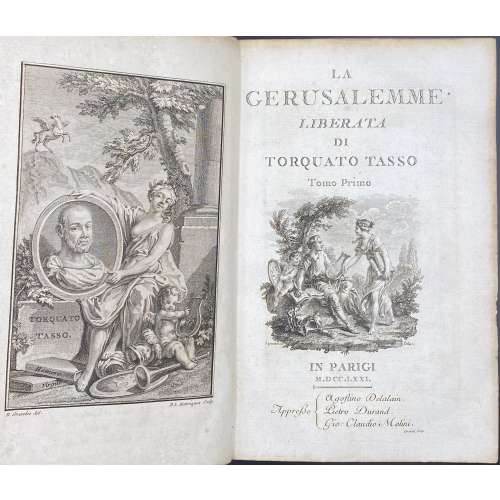 A two-volume set. Vol. 1:
A two-volume set. Vol. 1:Title: LA | GERUSALEMME | LIBERATA | DI | TORQUATO TASSO | Tomo Primo | {vignette} | IN PARIGI | M.DCC.LXXI | Appreßo { Agostino Delalain. | Pietro Durand. | Gio: Claudio Molini. | Droüet ∫crip.
Pagination: ffl [1] 2-331 [332] bfl; illustrations after Gravelot: frontis. by Henriquez, t.p. vignette by Patas, engraved dedication by Le Roy, 10 head- and 7 tailpieces by Le Roy, 5 full-page vignettes by Le Roy, and 10 plates by: Baquoy, Duclos (3), Le Roy, Lingée, Née, Rousseau, and Simonet (2).
Collation: 8vo; A-V8 X6.
Vol. 2: Title: LA | GERUSALEMME | LIBERATA | DI | TORQUATO TASSO | Tomo Secondo | {vignette} | IN PARIGI | M.DCC.LXXI | Appreßo { Agostino Delalain. | Pietro Durand. | Gio: Claudio Molini. | Droüet ∫crip. Pagination: ffl [1] 2-340 bfl; illustrations after Gravelot: frontis. by Henriquez, t.p. vignette by Mesnil, 10 head- and 6 tailpieces by Le Roy, 4 full-page vignettes by Le Roy, tailpiece by Ponce, and 10 plates by: Duclos, Henriquez, Leveau, Lingée, Massard, Née, Patas, Ponce, Rousseau, and Simonet. Collation: 8vo; A-X8 Y2. Size: 21.5 x 14.5 cm. Size of the copy sold at Sotheby's in 2015: 23.3 x 14.0 cm; Christie's in 2008: 23.2 x 14.4 cm Page size: 21 x 13.5 cm. In referenced sources, the page size is bigger than that. N. Ray gives 11 ½ x 8 7⁄8 inches or 9 x 5½ inches. Cohen and De Ricci do not bother to give sizes, considering that octavo is octavo. MFA: 30.3 x 23.1 x 4 cm (11 15/16 x 9 1/8 x 1 9/16 in.) Binding: Two volumes uniformly bound in full marbled calf, ruled in gilt, flat spine with gilt decorations and monogram, cream lettered label. Geoffrey Lord Cross of Chelsea [Geoffrey Cross, Baron Cross of Chelsea] (British, 1904 – 1989) bookplate to front pastedown. Catalogue raisonné: N. Ray №22, p. 48; Cohen De Ricci 974-975 According to MFA printing by: François-Augustin Quillau (French, 1743–1804). This edition was illustrated by Hubert François Gravelot (French, 1699–1773) and engraved by the following engravers: Jean Charles Baquoy (French, 1721–1777) Antoine Jean Duclos (French, 1742–1795) Benoît Louis Henriquez (French, 1732–1806) Jean Jacques André Le Veau (French, 1729–1785) Charles Louis Lingée (French, 1748–1819) Jacques Le Roy (French, born in 1739) Jean Massard (1740–1822) Elie du Mesnil (French, born about 1728) François Denis Née (French, 1735–1818) Charles Emmanuel Jean Baptiste Patas (French, 1744–1802) Nicholas Ponce (French, 1746–1831) Jean François Rousseau (French, born in 1740) Jean Baptiste Simonet (French, 1742–1813) Droüet (French, 18th century) -
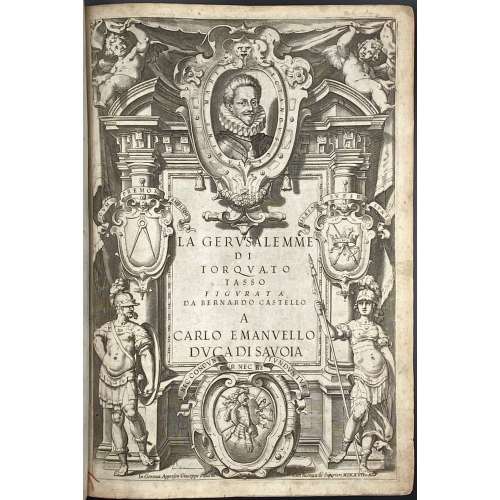 Engraved title-page 1, as per British Museum: An architectural setting with, at upper centre, a portrait of Carlo Emanuele I, Duke of Savoy, in an ornate cartouche lettered “"Spectandus Certamine Martio"; a central title “LA | GERUSALEMME | DI | TORQUATO | TASSO | FUGURATA A | DA BERNARDO CASTELLO | A | CARLO EMANUELLO | DVCA DI SAVOIA” flanked by Tuscan columns and crests with mottos and imprese showing compasses lettered "Dvm Premor Amplior", at left, and a crossed sword and sceptre with a crown lettered "Illaesa Super Sunt", at right; in the lower register, male and female figures in armour, perhaps representing Tancredi and Clorinda, with a central crest showing an impresa of armour”. Central title: Below, within frame: "In Genova, Appresso Giuseppe Pavoni. […] Con licenza de' Superiori. MDCXVII." Engraved title-page 2, as per British Museum: Portrait of Torquato Tasso, bust, facing front, wearing a laurel crown; within an oval pendant, lettered “TOROVATO […] TASSO EF”, suspended from a pediment, beneath which a view of Genoa is flanked by two columns, and above is a tablet, lettered: “LA GERUSALEMME | LIBERATA | DI TORQUATO | TASSO. | Con le annotazioni | di Scipion | Gentili, e di Givlio | Guastauini , | Et li argomenti di Oratio Ariosti , | STAMPATA | Per Giuseppe Pauoni ad instanza di | Bernardo Castello,in Genova | L’Anno MDCXVII." Collation: 8vo; 2 leaves of engraved title-pages, 1 leaf signed †2, 1 leaf unsigned, 2 leaves signed †† and ††2, respectively, 1 leaf unsigned, 1 leaf with engraving to verso (frontispiece to Canto Primo) —> 8 prelims (besides FEP or a blank leaf before 1st t.p.); π8 A-Q8 (pp. 1-255 [256 blank], plated within collation), G1, I1, K1, O1, and P1 (recto to plates without text) unsigned, L3 signed as second L2; A-D8 E4 (pp. 1-71 [72]; A-B8 C4 χ1 (pp. [1] 2-36 [37-40] [2]), in the 4-leaf quires E and C only two first leaves signed, in the 8-leaf quires four first leaves signed. Illustrations: woodcut head- and tail-pieces, woodcut initials, some historiated, and 20 plates within collation and pagination engraved by Camillo Cungio after Bernardo Castello. Binding: 30.5 x 21.4 cm overall, 30 x 20.5 cm leaves; contemporary vellum, rebacked with modern brown morocco, crimson morocco label with gilt lettering and double-fillet outline. Two bookplates to front pastedown: (1) Chippendale armorial bookplate (8.3 x 7.6 cm): Thos. Brand Esqr. Signed: W Austin — Fecit; (2) The Robin Collection bookplate. Bookseller’s ticket to back pastedown: “J. POOLE. | British & foreign | BOOKSELLER, | 39 BOOKSELLERS ROW, | STRAND |〰️| Books Bought.” All edges green. Provenance: The Robin Collection; Thomas Brand Hollis (British, 1719 – 1804). Contributors: Torquato Tasso (Italian, 1544 –1595) – author. Scipione Gentili [Scipio Gentilis] (Italian, 1563 – 1616) – author. Giulio Guastavini (Italian, fl. 16th century) – author. Bernardo Castello [Castelli] (Italian, 1557 – 1629) – artist. Camillo Cungi (Italian, fl. 1597 – 1649) – engraver. Giuseppe Pavoni (Italian, 1551 – c. 1641) – printer, publisher. Carlo Emanuele I, Duke of Savoy (Italian, 1562 – 1630) – dedicatee.
Engraved title-page 1, as per British Museum: An architectural setting with, at upper centre, a portrait of Carlo Emanuele I, Duke of Savoy, in an ornate cartouche lettered “"Spectandus Certamine Martio"; a central title “LA | GERUSALEMME | DI | TORQUATO | TASSO | FUGURATA A | DA BERNARDO CASTELLO | A | CARLO EMANUELLO | DVCA DI SAVOIA” flanked by Tuscan columns and crests with mottos and imprese showing compasses lettered "Dvm Premor Amplior", at left, and a crossed sword and sceptre with a crown lettered "Illaesa Super Sunt", at right; in the lower register, male and female figures in armour, perhaps representing Tancredi and Clorinda, with a central crest showing an impresa of armour”. Central title: Below, within frame: "In Genova, Appresso Giuseppe Pavoni. […] Con licenza de' Superiori. MDCXVII." Engraved title-page 2, as per British Museum: Portrait of Torquato Tasso, bust, facing front, wearing a laurel crown; within an oval pendant, lettered “TOROVATO […] TASSO EF”, suspended from a pediment, beneath which a view of Genoa is flanked by two columns, and above is a tablet, lettered: “LA GERUSALEMME | LIBERATA | DI TORQUATO | TASSO. | Con le annotazioni | di Scipion | Gentili, e di Givlio | Guastauini , | Et li argomenti di Oratio Ariosti , | STAMPATA | Per Giuseppe Pauoni ad instanza di | Bernardo Castello,in Genova | L’Anno MDCXVII." Collation: 8vo; 2 leaves of engraved title-pages, 1 leaf signed †2, 1 leaf unsigned, 2 leaves signed †† and ††2, respectively, 1 leaf unsigned, 1 leaf with engraving to verso (frontispiece to Canto Primo) —> 8 prelims (besides FEP or a blank leaf before 1st t.p.); π8 A-Q8 (pp. 1-255 [256 blank], plated within collation), G1, I1, K1, O1, and P1 (recto to plates without text) unsigned, L3 signed as second L2; A-D8 E4 (pp. 1-71 [72]; A-B8 C4 χ1 (pp. [1] 2-36 [37-40] [2]), in the 4-leaf quires E and C only two first leaves signed, in the 8-leaf quires four first leaves signed. Illustrations: woodcut head- and tail-pieces, woodcut initials, some historiated, and 20 plates within collation and pagination engraved by Camillo Cungio after Bernardo Castello. Binding: 30.5 x 21.4 cm overall, 30 x 20.5 cm leaves; contemporary vellum, rebacked with modern brown morocco, crimson morocco label with gilt lettering and double-fillet outline. Two bookplates to front pastedown: (1) Chippendale armorial bookplate (8.3 x 7.6 cm): Thos. Brand Esqr. Signed: W Austin — Fecit; (2) The Robin Collection bookplate. Bookseller’s ticket to back pastedown: “J. POOLE. | British & foreign | BOOKSELLER, | 39 BOOKSELLERS ROW, | STRAND |〰️| Books Bought.” All edges green. Provenance: The Robin Collection; Thomas Brand Hollis (British, 1719 – 1804). Contributors: Torquato Tasso (Italian, 1544 –1595) – author. Scipione Gentili [Scipio Gentilis] (Italian, 1563 – 1616) – author. Giulio Guastavini (Italian, fl. 16th century) – author. Bernardo Castello [Castelli] (Italian, 1557 – 1629) – artist. Camillo Cungi (Italian, fl. 1597 – 1649) – engraver. Giuseppe Pavoni (Italian, 1551 – c. 1641) – printer, publisher. Carlo Emanuele I, Duke of Savoy (Italian, 1562 – 1630) – dedicatee. -
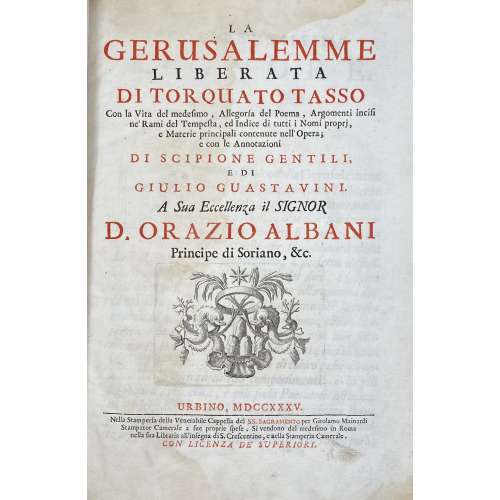 Title page (in red and black): LA | GERUSALEMME | LIBERATA | DI TORQUATO TASSO | Con la Vita del medesimo , Allegoria del Poema , Argomenti incisi | ne’Rami del Tempesta , ed Indice di tutti i Nomi proprj , | e Materie principali contenute nell’Opera ; | e con le Annotazioni | DI SCIPIONE GENTILI | E DI | GIULIO GUASTAVINI. | A Sua Eccellenza il SIGNOR | D. ORAZIO ALBANI | Principe di Soriano, &c. | {printer’s device} | URBINO, MDCCXXXV. | — | Nella Stamperia della Venerabile Cappella del SS. SAGRAMENTO per Girolamo Mainardi | Stampator Camerale a sue proprie spese . Si vendono dal medesimo in Roma | nella sua Libraria all’insegna di S. Crescentino, e nella Stamperia Camerale | CON LICENZA DE SUPERIORI. || Half-title: Title page: IL | GOFFREDO | OVVERO | LA GERUSALEMME | LIBERATA | DI | TORQUATO TASSO. || Collation: 4to; [2] blank leaves, [1] – h.t. / blank, [1] – t.p. / blank, [1] – dedication signed *2, [2] – vita, 1st signed *3, [2] – allegoria, [3] – indice, first two signed ** and **2, respectively, [1] – frontispiece to Canto Primo —> total 13 prelims; π13 (incl. 2 blanks), A-Z4 Aa-Bb4 Cc6 Dd-Qq4, χ1 (blank); 20 engraved frontispieces, one headpiece and initials, some historiated. Frontis. to Cantos II-XX incl. in collation and pagination; the number of leaves from A1 to Qq4 = 158; pagination: 1-316. The total number of leaves incl. prelims and blanks = 172. Note: three first leaves in the Cc quire of six leaves are signed; all other four-leaf quires only have the first two first leaves signed. Frontispiece to Canto Quarto cut down and laid down on D2v (as in Christie’s copy sold on 6 Jun 2010 – Live Auction 5475 – Fine Printed Books and Manuscripts, lot 168, price realized GBP 600). Illustrations: Frontispiece to Canto Primo signed “Arnoldo van Westerhout formis Roma”. Headpiece to Canto Primo signed “Eq. Petrus Leo Ghezius Inu. et. delin. — Frãn. Aquila incid.” Other plates unsigned but all attributed to Westerhout after Antonio Tempesta; Numeration of frontispieces in roman numbers, IIII for VI, VIIII for IX, XIIII for XIV, inverted numbers XVII, XVIII, and XIX, respectively: IIVX, IIIVX, and IIIIVX. Binding: 35 x 24 cm, 34 x 23 cm leaves, contemporary calf, rebacked retaining original spine, verso front flyleaf stamped “RESTORED BY MACDONALD CO. | NORWALK. CONN. Marbled endpapers, all edges red. Speckled calf, gilt triple-fillet borders, with remnants of blind-stamped and gilt design to an upper inside corner, spine with raised bands, gilt acorn tooling in compartments, later crimson label with gilt lettering. Damp staining to inside edges affecting all leaves. The Robin Collection bookplate to front pastedown. Provenance: The Robin Collection. Contributors: Torquato Tasso (Italian, 1544 –1595) – author. Scipione Gentili [Scipio Gentilis] (Italian, 1563 – 1616) Giulio Guastavini (Italian, fl. 16th century) Antonio Tempesta [Tempestino] (Italian, 1555 – 1630) – artist. Arnold [Arnoldo] van Westerhout (Flemish, 1651 – 1725) – artist, engraver. Pier Leone Ghezzi (Italian, 1674 – 1755) – artist. Francesco Faraone Aquila (Italian, c. 1676 – c. 1740) – engraver. Girolamo Mainardi (Italian, c. 1679 circa – 1763) – printer, publisher. Orazio Albani (Italian, 1576 – 1653) – dedicatee.
Title page (in red and black): LA | GERUSALEMME | LIBERATA | DI TORQUATO TASSO | Con la Vita del medesimo , Allegoria del Poema , Argomenti incisi | ne’Rami del Tempesta , ed Indice di tutti i Nomi proprj , | e Materie principali contenute nell’Opera ; | e con le Annotazioni | DI SCIPIONE GENTILI | E DI | GIULIO GUASTAVINI. | A Sua Eccellenza il SIGNOR | D. ORAZIO ALBANI | Principe di Soriano, &c. | {printer’s device} | URBINO, MDCCXXXV. | — | Nella Stamperia della Venerabile Cappella del SS. SAGRAMENTO per Girolamo Mainardi | Stampator Camerale a sue proprie spese . Si vendono dal medesimo in Roma | nella sua Libraria all’insegna di S. Crescentino, e nella Stamperia Camerale | CON LICENZA DE SUPERIORI. || Half-title: Title page: IL | GOFFREDO | OVVERO | LA GERUSALEMME | LIBERATA | DI | TORQUATO TASSO. || Collation: 4to; [2] blank leaves, [1] – h.t. / blank, [1] – t.p. / blank, [1] – dedication signed *2, [2] – vita, 1st signed *3, [2] – allegoria, [3] – indice, first two signed ** and **2, respectively, [1] – frontispiece to Canto Primo —> total 13 prelims; π13 (incl. 2 blanks), A-Z4 Aa-Bb4 Cc6 Dd-Qq4, χ1 (blank); 20 engraved frontispieces, one headpiece and initials, some historiated. Frontis. to Cantos II-XX incl. in collation and pagination; the number of leaves from A1 to Qq4 = 158; pagination: 1-316. The total number of leaves incl. prelims and blanks = 172. Note: three first leaves in the Cc quire of six leaves are signed; all other four-leaf quires only have the first two first leaves signed. Frontispiece to Canto Quarto cut down and laid down on D2v (as in Christie’s copy sold on 6 Jun 2010 – Live Auction 5475 – Fine Printed Books and Manuscripts, lot 168, price realized GBP 600). Illustrations: Frontispiece to Canto Primo signed “Arnoldo van Westerhout formis Roma”. Headpiece to Canto Primo signed “Eq. Petrus Leo Ghezius Inu. et. delin. — Frãn. Aquila incid.” Other plates unsigned but all attributed to Westerhout after Antonio Tempesta; Numeration of frontispieces in roman numbers, IIII for VI, VIIII for IX, XIIII for XIV, inverted numbers XVII, XVIII, and XIX, respectively: IIVX, IIIVX, and IIIIVX. Binding: 35 x 24 cm, 34 x 23 cm leaves, contemporary calf, rebacked retaining original spine, verso front flyleaf stamped “RESTORED BY MACDONALD CO. | NORWALK. CONN. Marbled endpapers, all edges red. Speckled calf, gilt triple-fillet borders, with remnants of blind-stamped and gilt design to an upper inside corner, spine with raised bands, gilt acorn tooling in compartments, later crimson label with gilt lettering. Damp staining to inside edges affecting all leaves. The Robin Collection bookplate to front pastedown. Provenance: The Robin Collection. Contributors: Torquato Tasso (Italian, 1544 –1595) – author. Scipione Gentili [Scipio Gentilis] (Italian, 1563 – 1616) Giulio Guastavini (Italian, fl. 16th century) Antonio Tempesta [Tempestino] (Italian, 1555 – 1630) – artist. Arnold [Arnoldo] van Westerhout (Flemish, 1651 – 1725) – artist, engraver. Pier Leone Ghezzi (Italian, 1674 – 1755) – artist. Francesco Faraone Aquila (Italian, c. 1676 – c. 1740) – engraver. Girolamo Mainardi (Italian, c. 1679 circa – 1763) – printer, publisher. Orazio Albani (Italian, 1576 – 1653) – dedicatee. -
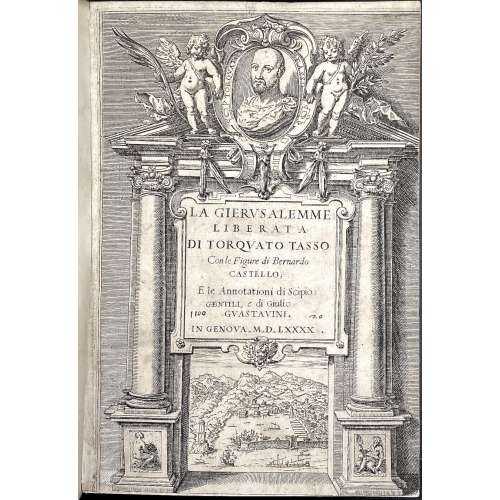 Engraved title with the portrait of Torquato Tasso, displayed in an oval medallion, bound in “TORQUATO TASSO”, between two naked putti; Architecture with two columns and Ionic capitals supporting an architectural pediment; between the columns is a table with the inscription: LA GIERVSALEMME | LIBERATA | DI TORQVATO TASSO | Con le Figure di Bernardo | CASTELLO; | E le Annotazioni di Scipio | GENTILI, e di Giulio | GVASTAVINI. | IN GENOVA. M.D.LXXXX .|| Contents: The 20 cantos are followed by: Tutte le stanza intere, che dall'autore sono state refiutate in questo libro; Annotationi di Scipio Gentili; Luoghi osservati dal mag. Giulio Guastavini, quali il Tasso nella sua Gierusalemme hà presi & imitati da poeti & altri scrittori antichi; Allegoria del poema; Tavola di tutti i nomi proprii et di tutte le materie principali contenute nel presente libro. Pagination: [2] engraved t.p. / blank, 3-11, [1] 2-255 [256], 1-71 [72] [1] 2-40, 4 unpag. leaves ‘Allegoria del poema’; total 387 pp. Collation: 8vo; π6 A-Q8 A-D8 E4 A-B8 χ4 (in the first quire M4 marked L4), ills. signed in collation. At p. 17 canto 3rd marked as 2nd, pp. 135 and 139 in 12th canto marked as 11th. Binding: later full polished calf, blind double-ruled covers, blind double-ruled raised bands, gilt lettering: GIERVSALEMME | LIBERATA and GENOVA | 1590. TMG. Printed on laid paper. Front joints split at head and tail. Title page and twenty full-page ill. facing the opening of each canto, engraved by Agostino Carracci and Giacomo Franco after Castello. Those for cantos 6-8, 10, 12, 16-17, 19-20 are by Carracci, 8 and 19 with his initials. The remainder are by Franco and are signed by him. Woodcut head and tailpieces, the Argomenti at the head of each canto within cartouches, initials. Catalogue raisonné: Adam Bartsch. Le peintre graveur. — Vienne: J. V. Degen, 1803.
Engraved title with the portrait of Torquato Tasso, displayed in an oval medallion, bound in “TORQUATO TASSO”, between two naked putti; Architecture with two columns and Ionic capitals supporting an architectural pediment; between the columns is a table with the inscription: LA GIERVSALEMME | LIBERATA | DI TORQVATO TASSO | Con le Figure di Bernardo | CASTELLO; | E le Annotazioni di Scipio | GENTILI, e di Giulio | GVASTAVINI. | IN GENOVA. M.D.LXXXX .|| Contents: The 20 cantos are followed by: Tutte le stanza intere, che dall'autore sono state refiutate in questo libro; Annotationi di Scipio Gentili; Luoghi osservati dal mag. Giulio Guastavini, quali il Tasso nella sua Gierusalemme hà presi & imitati da poeti & altri scrittori antichi; Allegoria del poema; Tavola di tutti i nomi proprii et di tutte le materie principali contenute nel presente libro. Pagination: [2] engraved t.p. / blank, 3-11, [1] 2-255 [256], 1-71 [72] [1] 2-40, 4 unpag. leaves ‘Allegoria del poema’; total 387 pp. Collation: 8vo; π6 A-Q8 A-D8 E4 A-B8 χ4 (in the first quire M4 marked L4), ills. signed in collation. At p. 17 canto 3rd marked as 2nd, pp. 135 and 139 in 12th canto marked as 11th. Binding: later full polished calf, blind double-ruled covers, blind double-ruled raised bands, gilt lettering: GIERVSALEMME | LIBERATA and GENOVA | 1590. TMG. Printed on laid paper. Front joints split at head and tail. Title page and twenty full-page ill. facing the opening of each canto, engraved by Agostino Carracci and Giacomo Franco after Castello. Those for cantos 6-8, 10, 12, 16-17, 19-20 are by Carracci, 8 and 19 with his initials. The remainder are by Franco and are signed by him. Woodcut head and tailpieces, the Argomenti at the head of each canto within cartouches, initials. Catalogue raisonné: Adam Bartsch. Le peintre graveur. — Vienne: J. V. Degen, 1803.Author: Written by Torquato Tasso (Italian, Sorrento 1544–1595 Rome)
Designer: Illustrations designed by Bernardo Castello (Italian, Genoa (?) 1557–1629 Genoa)
Engraver: Illustrations engraved by Agostino Carracci (Italian, Bologna 1557–1602 Parma)
Engraver: Illustrations engraved by Giacomo Franco (Italian, Venice 1550–1620 Venice)
Publisher: Published by Girolamo Bartoli , Genoa
Ref.: MET, HathiTrust, -
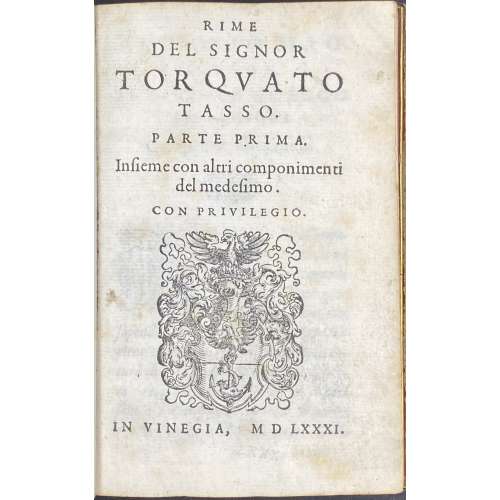 Title-page: RIME | DEL SIGNOR | TORQUATO | TASSO. | PARTE PRIMA. | Insieme con altri componimenti | del medesimo | CON PRIVILEGIO. | {publisher’s device} | IN VINEGIA, M D LXXXI. || Contents: 1. Rime; 2. Aminta favola boscareccia; 3. Conclusioni amorose; 4. Il Romeo, overo del Giuoco dialogo; 5. Lettera, nellaquale paragona l’Italia alla Francia; 6. All’eccellentis signor Duca di Urbino; 7. Dialogo del l’amor. Pagination: [2 blanks], [2] – t.p. / blank, [4] dedication, [2] – blank / content, [16] – tavola, [1] 2-160 – rime, [8] [1] 2-74 – aminta, [4] 1-9 [10 blank] – conclusion, [2] [1]-22 – dialogo, [2] 1-27 [28 blank] – lettera, [2] 1-4 – all’eccellentiss, [4 blanks], [2] 1-17 [18 blank] – dialogo del l’amor, [2] – Car. 52 / Car. 113., [4 blanks], total 372 pages. Collation: 8vo; first blank, *4, **8, A-K8, 2A-2L8 M4, last blank; total 186 leaves, incl. first and last blanks. Note: 2F2, 2G1, 2K4, 2L1, and 2M3,4 – unsigned. Binding: 15.2 x 10.3 cm, 19th-century polished calf by Duke St., St. James, London (ticket) Cambridge panels ruled in gilt with fleurons at corners, two crimson labels to spine with gilt lettering, gilt in compartments, raised bands ruled gilt, rebacked, AEG, bookplate to front pastedown: “BIBLIOTECA | del | Conte Leonardo Vitetti | Ambasciatore d’Italia” in a frame, and “The Robin Collection” to FEP. Inset a card from Bryn Mawr College Library. Provenance: Satinsky, Robin F. (American, 1919 – 2008), The Robin Collection. Count Leonardo Vitetti (Italian, 1895 – 1973) Bryn Mawr College Library (Pennsylvania) Contributors: Torquato Tasso (Italian, 1544 –1595) – author. Aldus Manutius, the Younger (Italian, 1547 – 1597) – printer, publisher.
Title-page: RIME | DEL SIGNOR | TORQUATO | TASSO. | PARTE PRIMA. | Insieme con altri componimenti | del medesimo | CON PRIVILEGIO. | {publisher’s device} | IN VINEGIA, M D LXXXI. || Contents: 1. Rime; 2. Aminta favola boscareccia; 3. Conclusioni amorose; 4. Il Romeo, overo del Giuoco dialogo; 5. Lettera, nellaquale paragona l’Italia alla Francia; 6. All’eccellentis signor Duca di Urbino; 7. Dialogo del l’amor. Pagination: [2 blanks], [2] – t.p. / blank, [4] dedication, [2] – blank / content, [16] – tavola, [1] 2-160 – rime, [8] [1] 2-74 – aminta, [4] 1-9 [10 blank] – conclusion, [2] [1]-22 – dialogo, [2] 1-27 [28 blank] – lettera, [2] 1-4 – all’eccellentiss, [4 blanks], [2] 1-17 [18 blank] – dialogo del l’amor, [2] – Car. 52 / Car. 113., [4 blanks], total 372 pages. Collation: 8vo; first blank, *4, **8, A-K8, 2A-2L8 M4, last blank; total 186 leaves, incl. first and last blanks. Note: 2F2, 2G1, 2K4, 2L1, and 2M3,4 – unsigned. Binding: 15.2 x 10.3 cm, 19th-century polished calf by Duke St., St. James, London (ticket) Cambridge panels ruled in gilt with fleurons at corners, two crimson labels to spine with gilt lettering, gilt in compartments, raised bands ruled gilt, rebacked, AEG, bookplate to front pastedown: “BIBLIOTECA | del | Conte Leonardo Vitetti | Ambasciatore d’Italia” in a frame, and “The Robin Collection” to FEP. Inset a card from Bryn Mawr College Library. Provenance: Satinsky, Robin F. (American, 1919 – 2008), The Robin Collection. Count Leonardo Vitetti (Italian, 1895 – 1973) Bryn Mawr College Library (Pennsylvania) Contributors: Torquato Tasso (Italian, 1544 –1595) – author. Aldus Manutius, the Younger (Italian, 1547 – 1597) – printer, publisher.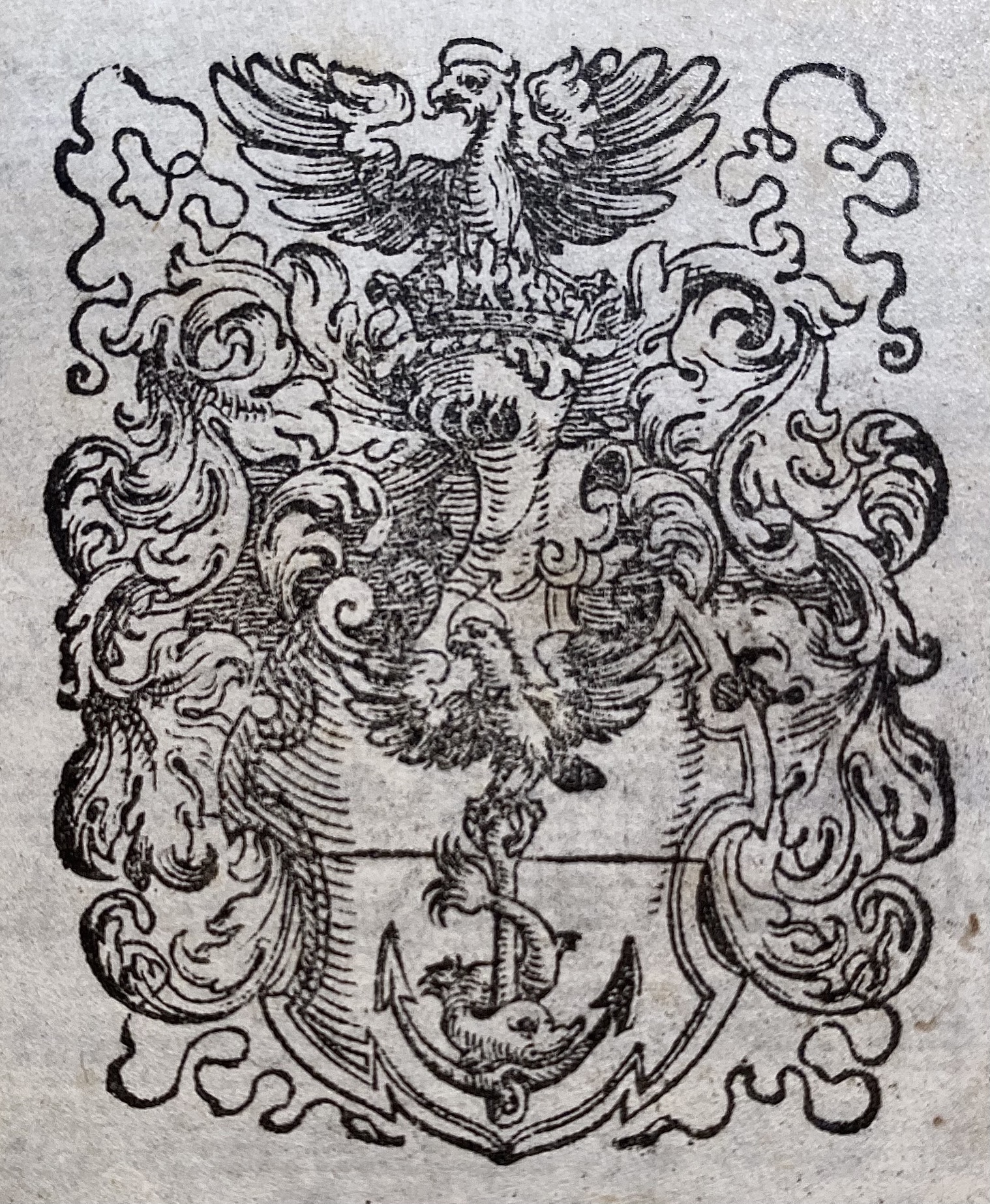
-
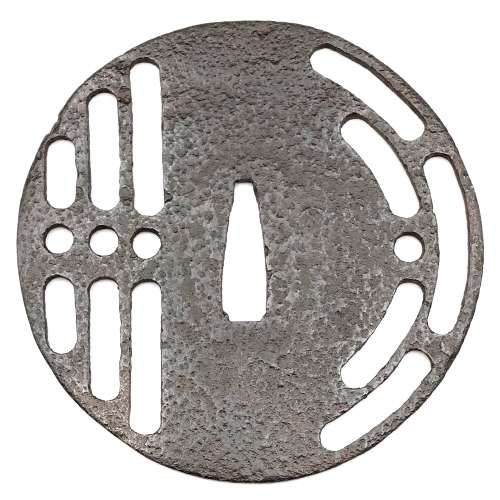 A very large and very thin iron tsuba of round form decorated with design of formalized butterfly and dragonfly in openwork (sukashi). The characteristics of the plate resemble those of Kamakura period ko-tōshō tsuba. However, the design seems too 'modern' to me, but it's hard to tell; it may be a late Muromachi or Momoyama period work. Tōshō or Ko-Tōshō school (or a Katchushi). Muromachi period. However, Boris Markhasin and Skip Holbrook insist this is a 20th-century machine-made tsuba. Dimensions: 99.6 x 100.5 x 2.1 mm. This is what Jim Gilbert says about old tsuba:
A very large and very thin iron tsuba of round form decorated with design of formalized butterfly and dragonfly in openwork (sukashi). The characteristics of the plate resemble those of Kamakura period ko-tōshō tsuba. However, the design seems too 'modern' to me, but it's hard to tell; it may be a late Muromachi or Momoyama period work. Tōshō or Ko-Tōshō school (or a Katchushi). Muromachi period. However, Boris Markhasin and Skip Holbrook insist this is a 20th-century machine-made tsuba. Dimensions: 99.6 x 100.5 x 2.1 mm. This is what Jim Gilbert says about old tsuba:"Traditionally the old iron plate tsuba are classified into Ko Tosho (old sword smith), and Ko Katchushi (old armor maker) styles. It is sometimes difficult to justify attribution of a given tsuba to the Tosho or Katchushi category. Generally guards with raised rims or relatively complex designs tend to be assigned to Katchushi. This is basically a convention we follow out of habit and convenience." [...] "In Token Kai-Shi part six, Articles by Akiyama Kyusaku, Robert Haynes comments: "…from 1300 to 1400 over 150,000 MOUNTED swords were made in Japan for export alone. This means that over four tsuba a day were made for 100 years. This would mean that at least 3000 persons were making nothing but tsuba, let alone all the other fittings needed to complete these swords. With sword smiths, fittings makers and all the other artists need to complete a sword for export, at least 10,000 sword artists were working together, in any one of these hundred years."
Another tsuba of similar design, Tōshō school, is illustrated in this collection; see TSU-0319.2015.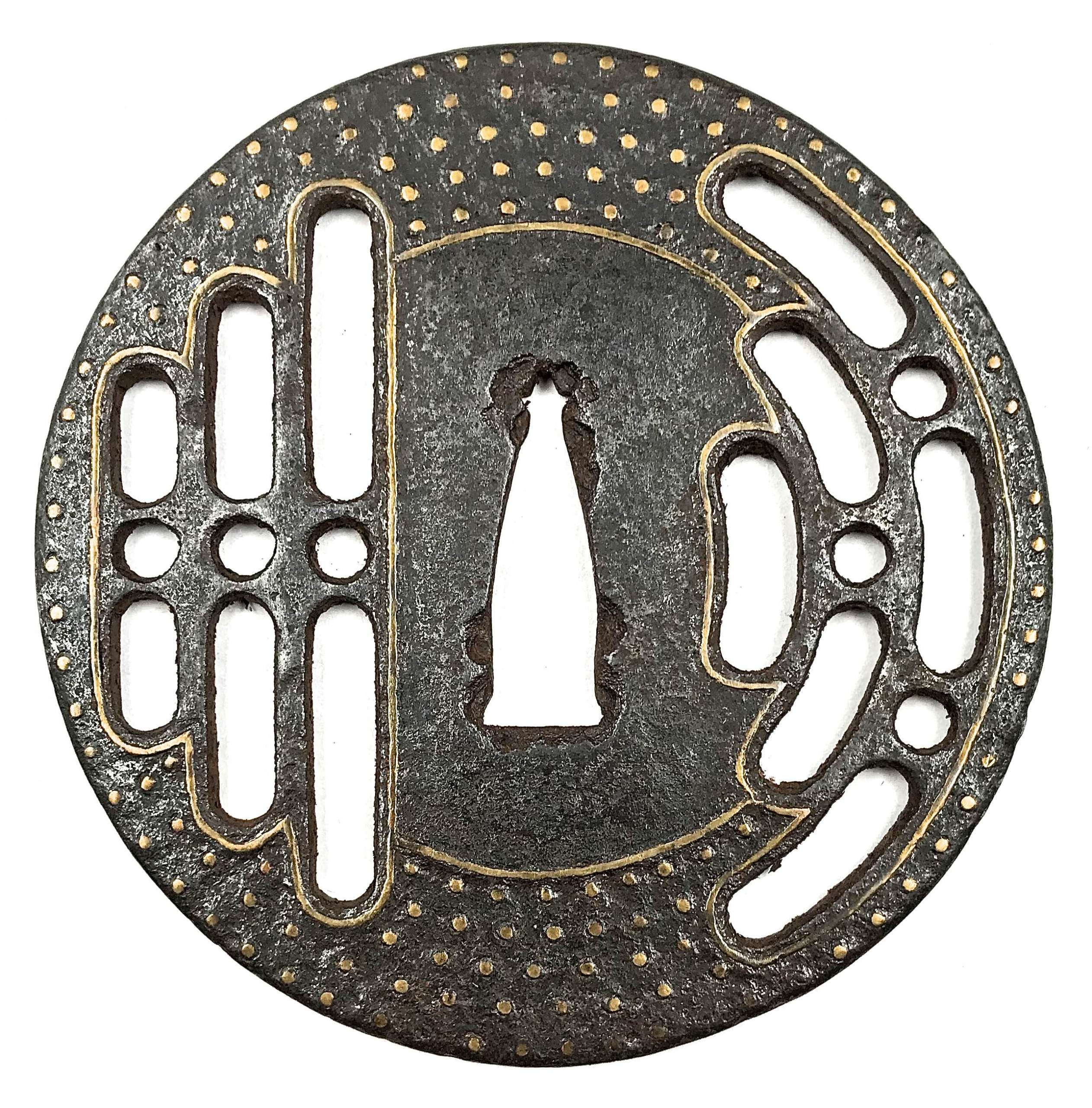 Reference to this design can be found in LIB-1359.2017 Japanese Swords and Tsuba from the Professor A. Z. Freeman and the Phyllis Sharpe Memorial collections, Sotheby's, London, Thursday 10 April 1997; p. 18-19, lot № 37: "A Kamakura-bori Tsuba, Momoyama Period. ...pierced with two large formalised butterflies..."
Reference to this design can be found in LIB-1359.2017 Japanese Swords and Tsuba from the Professor A. Z. Freeman and the Phyllis Sharpe Memorial collections, Sotheby's, London, Thursday 10 April 1997; p. 18-19, lot № 37: "A Kamakura-bori Tsuba, Momoyama Period. ...pierced with two large formalised butterflies..."

A Kamakura-bori tsuba of octagonal form, Momoyama period.
-
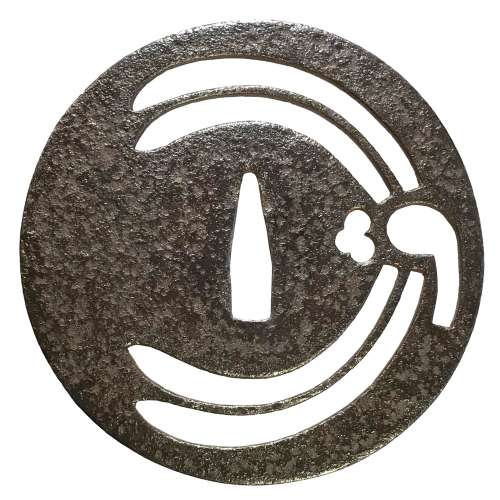 Iron tsuba of round form decorated with design of dragonfly in negative openwork (in-sukashi). It may be Ko-Tōshō (old Tōshō) or just Tōshō school, without a 'Ko'. Probably the dragonfly here is used as a family crest (mon). Muromachi period. However, Boris Markhasin and Skip Holbrook insist this is a 20th-century machine-made tsuba. Dimensions: Height: 95.0 mm. Width: 93.6 mm. Rim thickness: 2.1 mm. Center thickness: 2.3 mm. Nakago-ana: height = 30 mm, width = 7.8 mm. A dragonfly design is described by John W. Dower as following "During the period of feudal warfare, the dragonfly is reputed to have been am especially popular design applied to arrow quivers, and some warriors adopted it as a family crest. One reason for this was the insect's alternative names of katsu mushi and shogun mushi, both meaning 'victory insect'." Merrily Baird is even more talkative regarding the matter: "The dragonfly (tombo) in Japan is emblematic of martial success, as various names for the insect are homophones for words meaning "victory". The dragonfly is also auspicious because references in the Kojiki and Nihongi link it in both name and shape to the old kingdom of Yamato. This legacy has led to the use of dragonfly as an emblem on arrow quivers and as family crest. It also appears occasionally in conjunction with such imperial motifs as the chrysanthemum. Used in a context devoid of historical associations, the dragonfly is a seasonal symbol of late summer and early autumn." Dragonfly was an extremely often motif for the tsuba in all times, primarily in earlier times, before Tokugawa pacified the nation. The same motif is used on Ōnin tsuba in this collection:
Iron tsuba of round form decorated with design of dragonfly in negative openwork (in-sukashi). It may be Ko-Tōshō (old Tōshō) or just Tōshō school, without a 'Ko'. Probably the dragonfly here is used as a family crest (mon). Muromachi period. However, Boris Markhasin and Skip Holbrook insist this is a 20th-century machine-made tsuba. Dimensions: Height: 95.0 mm. Width: 93.6 mm. Rim thickness: 2.1 mm. Center thickness: 2.3 mm. Nakago-ana: height = 30 mm, width = 7.8 mm. A dragonfly design is described by John W. Dower as following "During the period of feudal warfare, the dragonfly is reputed to have been am especially popular design applied to arrow quivers, and some warriors adopted it as a family crest. One reason for this was the insect's alternative names of katsu mushi and shogun mushi, both meaning 'victory insect'." Merrily Baird is even more talkative regarding the matter: "The dragonfly (tombo) in Japan is emblematic of martial success, as various names for the insect are homophones for words meaning "victory". The dragonfly is also auspicious because references in the Kojiki and Nihongi link it in both name and shape to the old kingdom of Yamato. This legacy has led to the use of dragonfly as an emblem on arrow quivers and as family crest. It also appears occasionally in conjunction with such imperial motifs as the chrysanthemum. Used in a context devoid of historical associations, the dragonfly is a seasonal symbol of late summer and early autumn." Dragonfly was an extremely often motif for the tsuba in all times, primarily in earlier times, before Tokugawa pacified the nation. The same motif is used on Ōnin tsuba in this collection: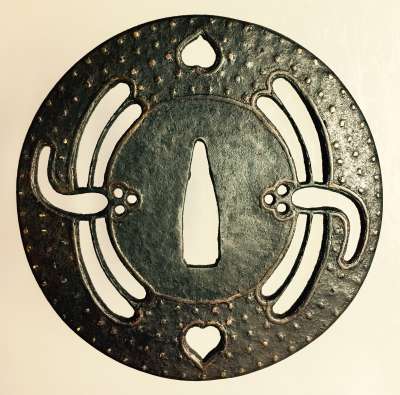
-
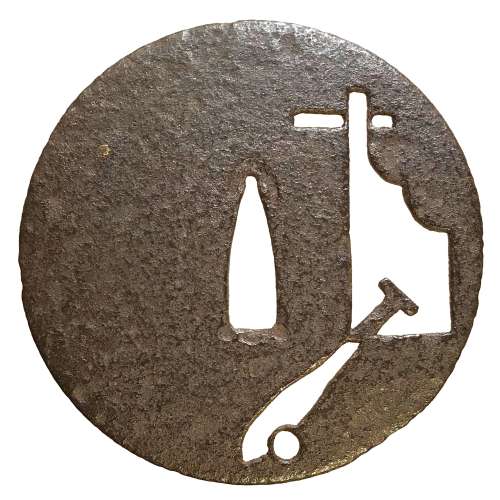 Round tsuba of iron; well forged thin plate decorated with a rudder (kaji) and an oar, or paddle (kai) with a water drop, executed in a combination of negative (in-sukashi) and positive (ji-sukashi) openwork. It may be Ko-Tōshō (old Tōshō) or just Tōshō school, without a 'Ko'. The characteristics of the plate point toward an older piece, however the combination of negative and positive silhouettes pulls the date of manufacture in an opposite direction. Muromachi period. Height: 90.0 mm. Width: 89.0 mm. Rim thickness: 2.1 mm. Center thickness: 2.3 mm. Nakago-ana: height = 29 mm, width = 8.8 mm. A rudder and an oar design is classified by John W. Dower as "Sailing vessels and gear": "Unlike many other motifs, sailing vessels and sailing gear failed to collect an interesting lore or to develop levels of meaning." Merrily Baird does not say anything about these symbols. Yuzuri Okada says: "Ships, sails, rudders, etc. also supply motive of the same class as wheels." He does not provide us with the description of the motive supplied by the wheel. The same motif is used on Ōnin tsuba in this collection:
Round tsuba of iron; well forged thin plate decorated with a rudder (kaji) and an oar, or paddle (kai) with a water drop, executed in a combination of negative (in-sukashi) and positive (ji-sukashi) openwork. It may be Ko-Tōshō (old Tōshō) or just Tōshō school, without a 'Ko'. The characteristics of the plate point toward an older piece, however the combination of negative and positive silhouettes pulls the date of manufacture in an opposite direction. Muromachi period. Height: 90.0 mm. Width: 89.0 mm. Rim thickness: 2.1 mm. Center thickness: 2.3 mm. Nakago-ana: height = 29 mm, width = 8.8 mm. A rudder and an oar design is classified by John W. Dower as "Sailing vessels and gear": "Unlike many other motifs, sailing vessels and sailing gear failed to collect an interesting lore or to develop levels of meaning." Merrily Baird does not say anything about these symbols. Yuzuri Okada says: "Ships, sails, rudders, etc. also supply motive of the same class as wheels." He does not provide us with the description of the motive supplied by the wheel. The same motif is used on Ōnin tsuba in this collection: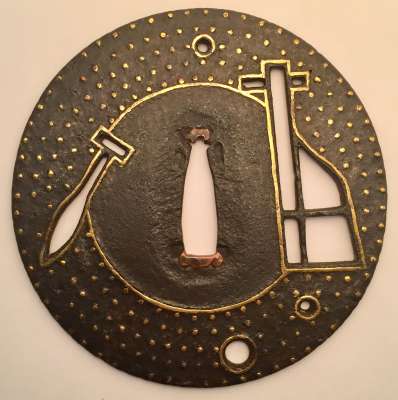
-
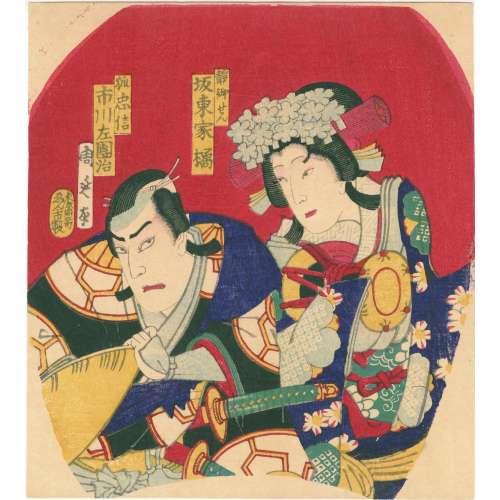 Artist: Toyohara Chikanobu [豊原周延] (Japanese, 1838 – 1912) Signed: Chikanobu ga [周延画] Publisher: [ 東京掘江町] Tokyo Horiemachi | [えん市製] Enshi-sei. Media: Fan print (uchiwa-e, 団扇絵), 192 x 172 mm. Actors: Female: Bandō Kakitsu I in the role of Shizuka Gozen [静御前]. Male: Ichikawa Sadanji I in the role of Kitsune Tadanobu [狐忠信], a.k.a. Satō Tadanobu [佐藤 忠信]. Bandō Kakitsu I [初代 坂東 家橘] (Japanese, 1847 – 1893); other names: Ichimura Kakitsu V, Ichimura Uzaemon XIV, Ichimura Kakitsu V, Ichimura Uzaemon XIV, Ichimura Takematsu III. Ichikawa Sadanji I [市川左団次] (Japanese, 1842 – 1904); other names: Ichikawa Shōjaku I, Ichikawa Koyone, Ichikawa Tatsuzō.
Artist: Toyohara Chikanobu [豊原周延] (Japanese, 1838 – 1912) Signed: Chikanobu ga [周延画] Publisher: [ 東京掘江町] Tokyo Horiemachi | [えん市製] Enshi-sei. Media: Fan print (uchiwa-e, 団扇絵), 192 x 172 mm. Actors: Female: Bandō Kakitsu I in the role of Shizuka Gozen [静御前]. Male: Ichikawa Sadanji I in the role of Kitsune Tadanobu [狐忠信], a.k.a. Satō Tadanobu [佐藤 忠信]. Bandō Kakitsu I [初代 坂東 家橘] (Japanese, 1847 – 1893); other names: Ichimura Kakitsu V, Ichimura Uzaemon XIV, Ichimura Kakitsu V, Ichimura Uzaemon XIV, Ichimura Takematsu III. Ichikawa Sadanji I [市川左団次] (Japanese, 1842 – 1904); other names: Ichikawa Shōjaku I, Ichikawa Koyone, Ichikawa Tatsuzō. -
 Artist: Toyohara Chikanobu [豊原周延] (Japanese, 1838 – 1912) Signed: Chikanobu hitsu [周延筆] Publisher: [ 東京掘江町] Tokyo Horiemachi | [えん市製] Enshi-sei. Media: Fan print (uchiwa-e, 団扇絵), 192 x 172 mm. Possibly Iwai Kumesaburō IV [岩井粂三郎] (1856 – 1886) a.k.a. Iwai Hisajirō III [岩井久次郎] in the role of Ono no Komachi [小野乃小町] and Nakamura Shikan IV [中村芝翫] in the role of Kisen Hōshi [喜せん法師]. Play: The Six Immortal Poets in Colorful Guises [六歌仙体綵] (Rokkasen Sugata no irodori). Inscription: Left: Kisen [喜せん] | Shikan [芝翫] Right: Komachi [小町] | Kumesaburō [粂三郎]. Actors: Iwai Kumesaburō IV [岩井粂三郎] (1856 – 1886) a.k.a. Iwai Hisajirō III [岩井久次郎]. Nakamura Shikan IV [中村芝翫] (Japanese, 1831 – 1899); other names: Nakamura Fukusuke I [中村福助], Nakamura Masanosuke I, Nakamura Komasaburō, Nakamura Tamatarō I.
Artist: Toyohara Chikanobu [豊原周延] (Japanese, 1838 – 1912) Signed: Chikanobu hitsu [周延筆] Publisher: [ 東京掘江町] Tokyo Horiemachi | [えん市製] Enshi-sei. Media: Fan print (uchiwa-e, 団扇絵), 192 x 172 mm. Possibly Iwai Kumesaburō IV [岩井粂三郎] (1856 – 1886) a.k.a. Iwai Hisajirō III [岩井久次郎] in the role of Ono no Komachi [小野乃小町] and Nakamura Shikan IV [中村芝翫] in the role of Kisen Hōshi [喜せん法師]. Play: The Six Immortal Poets in Colorful Guises [六歌仙体綵] (Rokkasen Sugata no irodori). Inscription: Left: Kisen [喜せん] | Shikan [芝翫] Right: Komachi [小町] | Kumesaburō [粂三郎]. Actors: Iwai Kumesaburō IV [岩井粂三郎] (1856 – 1886) a.k.a. Iwai Hisajirō III [岩井久次郎]. Nakamura Shikan IV [中村芝翫] (Japanese, 1831 – 1899); other names: Nakamura Fukusuke I [中村福助], Nakamura Masanosuke I, Nakamura Komasaburō, Nakamura Tamatarō I. -
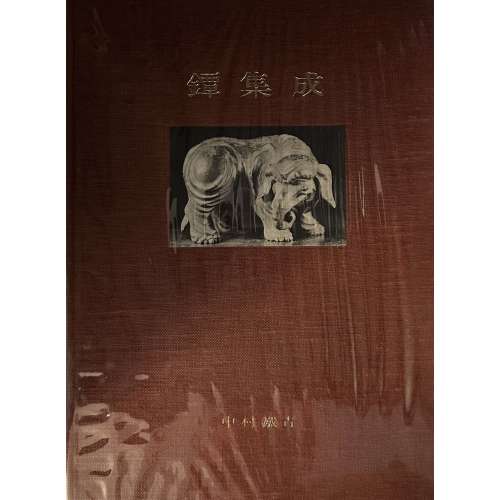 NEWA large hardcover volume, 370 x 265 x 53 mm, bound in burgundy cloth with pasted-in b/w photograph and gilt lettering to front, gilt lettering to spine, in plastic dust jacket, in a slipcase, in a cardboard shipping box, pp. [2] 1-522 [2], 128 leaves total; limited edition of 1000 copies. Author: Nakamura Tessei [中村鐵青] Seller's description: Tsuba Shusei by Nakamura. 1963. Of a limited edition of 1,000. Clothbound with plastic jacket, slipcase, and cardboard storage box, 11 ½ x 14 ½”, 522 heavy stock pages in Japanese. This is a very impressive book. Thousands of tsuba, from Kamakura to late Edo and arranged by school. are illustrated (24 in colour photos and the rest in black & white) and described. If there is a tsuba bible this might be it; there can’t be a more comprehensive book on the subject. The storage box is shelf worn, the slipcase is just a bit toned; the book is in excellentt condition. Produced by Chuokoron-Shinsha, Inc. [株式会社中央公論新社] Publisher: 銀集成刊行会 Production details: 鐵集成 第617番 昭和38年2月10日発行 限定1,000部 定価 10,000円 オフセット単色印刷:マイク印刷 オフセット原色印刷:大日本印刷 著者中村鐵青 製作 中央公論事業出版 発行所 銀集成刊行会 活版印刷:精興社 製本:協和製本 本文用紙:三菱製紙 表紙:望月
NEWA large hardcover volume, 370 x 265 x 53 mm, bound in burgundy cloth with pasted-in b/w photograph and gilt lettering to front, gilt lettering to spine, in plastic dust jacket, in a slipcase, in a cardboard shipping box, pp. [2] 1-522 [2], 128 leaves total; limited edition of 1000 copies. Author: Nakamura Tessei [中村鐵青] Seller's description: Tsuba Shusei by Nakamura. 1963. Of a limited edition of 1,000. Clothbound with plastic jacket, slipcase, and cardboard storage box, 11 ½ x 14 ½”, 522 heavy stock pages in Japanese. This is a very impressive book. Thousands of tsuba, from Kamakura to late Edo and arranged by school. are illustrated (24 in colour photos and the rest in black & white) and described. If there is a tsuba bible this might be it; there can’t be a more comprehensive book on the subject. The storage box is shelf worn, the slipcase is just a bit toned; the book is in excellentt condition. Produced by Chuokoron-Shinsha, Inc. [株式会社中央公論新社] Publisher: 銀集成刊行会 Production details: 鐵集成 第617番 昭和38年2月10日発行 限定1,000部 定価 10,000円 オフセット単色印刷:マイク印刷 オフセット原色印刷:大日本印刷 著者中村鐵青 製作 中央公論事業出版 発行所 銀集成刊行会 活版印刷:精興社 製本:協和製本 本文用紙:三菱製紙 表紙:望月 -
 Iron tsuba of the round form (丸型, maru–gata), decorated with brass flat inlay (平象嵌, hira-zōgan) of bellflowers, leaves, and vines on both sides, inlaid brass is carved in low relief; wide rim (dote-mimi) also inlaid; the plate is pierced with hitsu-ana (probably original); nakago-ana plugged with copper sekigane. Dimensions: Height: 84.1 mm; Width: 82.0 mm; Thickness (centre): 2.8 mm; mimi is 11.8 mm wide and 4.7 mm thick. Produced at the end of the 16th century, in the Momoyama period (1674–1703).
Iron tsuba of the round form (丸型, maru–gata), decorated with brass flat inlay (平象嵌, hira-zōgan) of bellflowers, leaves, and vines on both sides, inlaid brass is carved in low relief; wide rim (dote-mimi) also inlaid; the plate is pierced with hitsu-ana (probably original); nakago-ana plugged with copper sekigane. Dimensions: Height: 84.1 mm; Width: 82.0 mm; Thickness (centre): 2.8 mm; mimi is 11.8 mm wide and 4.7 mm thick. Produced at the end of the 16th century, in the Momoyama period (1674–1703).


